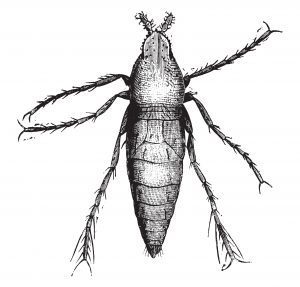Help! What Can I Do About Chiggers?
By Chris Williams on April 23, 2012.
Chiggers are tiny red mites that are sometimes called “redbugs.” They are so tiny that most people can’t see them. But when chiggers bite, they cause days of intense itching far out of proportion to their small size. When someone walks, or worse, lies down or plays in an area infested with chiggers, they don’t soon forget the experience.
Adult chiggers spend the winter in protected places and lay eggs in the spring. The young chiggers, called larvae, that hatch from the eggs are the troublemakers. They’re the ones that attack people, as well as other mammals, birds, reptiles, and amphibians. After feeding on a person (or animal) for a few days, the reddish larva drops off and transforms into a nymph. Nymphs and adult chiggers are predators on insects and don’t bite people. Chiggers don’t transmit any diseases in the U.S.
 Where Are the Chiggers Coming From? –Larval chiggers wait near the tips of grasses, weeds, sticks, or other objects close to the ground until a person or other animal passes by. Unfortunately, you can’t tell simply by looking whether a site is infested with chiggers. Chiggers are most often found in transition zones such as where woods meet grass, and in low, damp places where vegetation is dense. Examples include berry patches, thickets, patches of scrub vegetation, and the margins of woods, orchards, and streams, particularly in areas where there are other host animals for the chiggers such as rabbits, mice, and other small animals. But some chigger species are adapted to drier locations so even lawns can be infested. In our area, chiggers are active from early summer to fall, particularly after periods of rain.
Where Are the Chiggers Coming From? –Larval chiggers wait near the tips of grasses, weeds, sticks, or other objects close to the ground until a person or other animal passes by. Unfortunately, you can’t tell simply by looking whether a site is infested with chiggers. Chiggers are most often found in transition zones such as where woods meet grass, and in low, damp places where vegetation is dense. Examples include berry patches, thickets, patches of scrub vegetation, and the margins of woods, orchards, and streams, particularly in areas where there are other host animals for the chiggers such as rabbits, mice, and other small animals. But some chigger species are adapted to drier locations so even lawns can be infested. In our area, chiggers are active from early summer to fall, particularly after periods of rain.
How Can You Tell If It’s a Chigger Bite? –You really can’t tell for sure if it’s a chigger bite. But once you’ve had a couple of chigger bites, you learn how you react to them and you’ll soon recognize them. Chigger bites tend to itch more than any other type of bite. Chiggers don’t suck blood and they don’t burrow into your skin as many people think. They insert their mouthparts into hair follicles or pores which serves to anchor them to the skin. They then inject a digestive fluid that dissolves the tissues so the chiggers can suck up the liquefied tissue. Over a period of days, the surrounding tissues become hardened, red, and swollen. Chiggers often feed where clothing is tight (ankles, crotch, waistline, or armpits). The itching usually starts 3 to 6 hours after attachment and may last for up to two weeks. Scratching usually removes the mite but not before the reaction has set in.
What Can You Do About Chiggers? –It’s difficult to control chiggers with insecticides since they can be anywhere and they can’t be easily seen. Prevention is your best control tactic. When in areas where chiggers are suspected, wear long sleeves and pants and use an insect repellent, especially around the ankles. Immediately after expected exposure, take a thorough soapy shower to remove chiggers. Launder clothes right away too, since chiggers can remain on clothes for some time.
In your yard, remove brush and berry thickets and keep lawns mowed close. If you know where the chiggers are concentrated in your yard, sometimes a pest control company can treat those specific areas. Or, you can have just high-risk areas such as around swing sets or picnic tables treated.